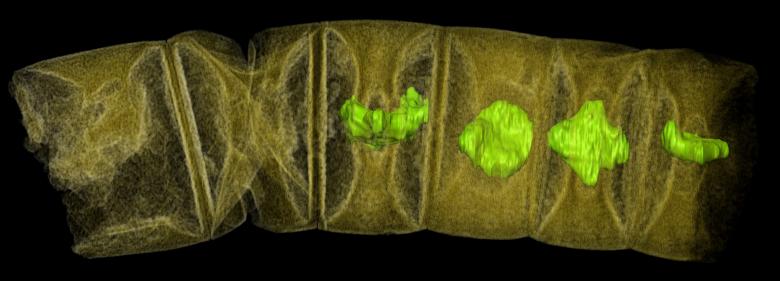This past month saw two groundbreaking studies probing into the earliest signs of both bacterial and plant life on earth.
On March 1, a study was published in the journal Nature, identifying microfossils between 3.8 and 4.3 billion years in age that were found in an area known as the Nuvvuagittuq Supracrustal Belt (NSB), on the coast of Hudson Bay, in Canada’s Quebec province. The NSB is a segment of ocean floor containing some of the oldest volcanic and sedimentary rocks known to science. Within layers of quartz found at the site were tubes and tendrils of hematite, a form of iron oxide or rust, that the report cites as likely to have been deposited by bacteria that oxidized iron for energy. According to the study, the fossils are similar to the bacteria that thrive today around undersea hydrothermal vents, and may be evidence of the oldest life on earth.
According to Matthew Dodd, the University College London (UCL) biogeochemist who authored the study, if the fossils are 4.3 billion years old, this discovery would indicate “an almost instantaneous emergence of life” after ocean formation. The earth formed about 4.5 billion years ago, followed by oceans about 4.4 billion years ago.
This discovery was quickly followed by the release last week of a study published in the journal PLOS Biology, by Swedish Museum of Natural History geobiologist Therese Sallstedt and paleobiologist, Stefan Bengtson, with Veneta Belivanova, and Martin Whitehouse. The study found that 1.6 billion year old fossils unearthed in India may represent the earliest known plant life. Researchers described the fossils as two types of red algae that lived in a shallow marine environment alongside mats of bacteria. The oldest known plants were considered to be 1.2 billion year old red algae fossils from the Canadian Arctic.

According to Therese Sallstedt, “plants have a key role for life on Earth, and we show here that they were considerably older than what we knew, which has a ripple effect on our appreciation of when advanced life forms appeared on the evolutionary scene.”
Matthew Dodd said that the UCL study shows that the discovery of “an almost instantaneous emergence of life” after ocean formation may have implications beyond earth.
“These discoveries demonstrate life developed on Earth at a time when Mars and Earth had liquid water at their surfaces, posing exciting questions for extra-terrestrial life. Therefore, we expect to find evidence for past life on Mars 4,000 million years ago, or if not, Earth may have been a special exception,” said Dodd.
The UCL team extrapolated on the implications of the discovery, saying that Mars is thought to have had oceans billions of years ago, that could have been conducive to life.
Late in February, NASA identified seven planets of a similar size to earth, all orbiting the same sun, all of which could have water. With these new studies it is possible life could have emerged much sooner than thought on these planets.
Need a recap of today’s TRAPPIST-1 announcement? Learn about these 7 Earth-sized planets orbiting a single star here https://t.co/R9xd5Dytlp pic.twitter.com/qWrE4R3flv
— NASA (@NASA) February 22, 2017
LIMA CHARLIE NEWS
Lima Charlie provides global news, insight & analysis by military veterans and service members Worldwide.
For up-to-date news, please follow us on twitter at @LimaCharlieNews
[Main photo image (Matthew Dodd): Hematite tubes from hydrothermal vent deposits, microfossils at least 3.8 billion years old.]

![Image China and U.S. Freedom of Navigation Operations collide in the South China Sea [Lima Charlie News]](https://limacharlienews.com/wp-content/uploads/2018/10/SCS-0000001-480x384.png)
![Image Critics of India's ruling government rounded up in raids [Lima Charlie News][Image: AFP]](https://limacharlienews.com/wp-content/uploads/2018/09/Critics-of-Indias-ruling-government-rounded-up-in-raids-480x384.jpg)
![Image International students face narrowing opportunities to remain in the US after graduation [Lima Charlie News]](https://limacharlienews.com/wp-content/uploads/2018/08/International-students-face-narrowing-opportunities-to-remain-in-the-US-after-graduation-480x384.png)
![Image Pakistan’s military and its largest political party face off [Lima Charlie News][Photo: Reuters]](https://limacharlienews.com/wp-content/uploads/2018/07/Pakistan’s-military-and-its-largest-political-party-face-off-480x384.jpg)
![Image Texas Oil Boom Causes Headaches [Lima Charlie News][Photo: Marie D. De Jesus]](https://limacharlienews.com/wp-content/uploads/2018/07/Texas-Oil-Boom-Causes-Headaches-480x384.jpg)